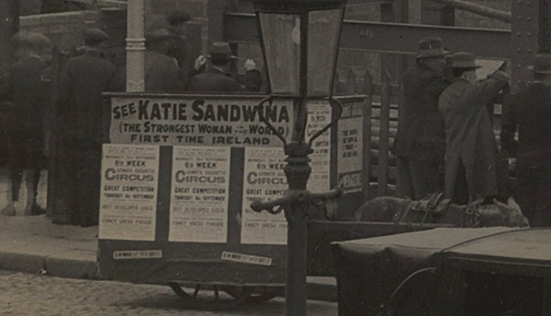By Conor Heffernan
In 1928 strongwoman Katie Brumbach or ‘Katie Sandwina’ (born in Austria in 1884) spent roughly a month touring Ireland with Carmo’s Circus. Billed in some quarters as ‘Catherine the Great’, Sandwina entered theatres on a Roman chariot and spent the next 20–30 minutes flexing her muscles, lifting heavy weights and responding to the audience’s reactions. Weighing fifteen stone and standing at over six feet tall, Sandwina bent bars, broke chains and lifted members of the audience. In the words of one observer, the effect of such theatrics was absolutely ‘stupendous’.
STRONGMEN—BUT NOT STRONGWOMEN—COMMON
Sandwina was not the first strength athlete to tour Ireland. Since the late nineteenth century Irish and European strongmen had profitably performed around the country. The German strongman Eugen Sandow briefly stopped in Queenstown in 1893 and was quickly immortalised in a Murphy’s Stout advertisement showing Sandow lifting a horse overhead. This, incidentally, pre-dated the ‘Guinness for Strength’ campaign by several decades. Irish strongman John Moriarty enjoyed a several-decade career in Duffy’s Circus, while other strongmen, like Canadian Louis Cyr, were admired from afar.
Strongmen were well known in Ireland; strongwomen were not. The last strongwoman to perform here was Julia Verilere (‘Victorina’) in Belfast in 1884. This partly explains why Sandwina’s performances were much anticipated by Irish audiences and journalists alike. She was truly unique in an Irish context; female strength acts were a rare occurrence for an Irish public used to performances of male strength.
‘PHYSICAL CULTURE’
While a great deal of work has focused on the rise of associational sports in Ireland like the GAA, soccer or rugby in the late nineteenth and early twentieth centuries, relatively little research has discussed the rise of ‘physical culture’. No longer a phrase used in modern parlance, physical culture, which began to become a popular term in Ireland from the 1880s, meant strengthening and shaping one’s body. It was not confined to Ireland but was a global phenomenon. Thus, when Irishmen and women wanted to become physical culturists, they read works from Europe and America. This also explains why European strongmen were revered in Irish theatres, impressing crowds with feats involving heavy dumbbells, barbells, livestock and audience members.
Katie Sandwina advertised herself as a physical culturist and emulated many of the feats of her male counterparts. Where men’s physical culture encouraged the strengthening and enlargement of muscles, women’s physical culture typically focused on gentle exercises designed to create slim, svelte bodies. Irishwomen were told that the only physical culture they needed was housework—or, in one strange case, exercising with balloons! Jan Todd in her work on women’s exercise has explained that restrictive ideas about women’s role in the home, the supposed frailty of their bodies and a desire to avoid overexertion meant that women’s physical culture was very unambitious when compared to men’s exercise.

This was certainly the case in both pre- and post-partition Ireland. That Sandwina was clearly strong, and much stronger than the average man, helps to explain the curiosity provoked by her Irish visit. Sandwina was not entirely unknown in Ireland. Irishmen and, in some cases, Irishwomen had subscribed to physical culture magazines from the early 1900s. Produced in Britain and America, these magazines publicised feats of strength, gave training advice and provided a space for people to indulge their health interest.
Although these magazines would be banned in the Irish Free State in the early 1930s because of the half-nude muscular physiques they displayed, they flourished during the 1920s. As one of the few strongwomen to have a career spanning several decades, Sandwina was a regular feature. This celebrity extended to Irish newspapers, who reported on her tours of Britain in 1926.
‘INCREDIBLE FEATS OF STRENGTH AND ENDURANCE’ When Sandwina came to Ireland two years later, Irishwomen’s physical culture was still restricted to light exercise classes designed to move but not strengthen the body. Sandwina stood in contrast to this approach. Few could associate her with the watered-down exercises found in women’s physical culture classes.
When Sandwina came to Ireland two years later, Irishwomen’s physical culture was still restricted to light exercise classes designed to move but not strengthen the body. Sandwina stood in contrast to this approach. Few could associate her with the watered-down exercises found in women’s physical culture classes.
As part of Carmo’s Circus, Sandwina spent several weeks touring Leinster theatres. She performed not only in Dublin but also in several satellite counties. In Drogheda, for example, Sandwina bent iron bars, and snapped strong chains. At one point she supported a blacksmith’s anvil on her chest, lay on a board of nails and let three men from the audience smash the anvil with sledgehammers. This was a typical strength performance feat but one that still impressed. Later in the performance, she placed a platform—supposedly weighing a ton—across her back and supported a merry-go-round on top. For her finale, Sandwina used the same platform to support a bridge which several men, and even three heavy horses, walked across. Of that night’s proceedings, which included singers, motor cars and a ‘mass of flames’, Sandwina was cited as the main attraction. She certainly left a mark on the 600-person crowd!
For many in the press the next day, Sandwina lived up to her title as ‘positively the greatest attraction ever brought to Ireland’. The Meath Herald commented that she had set the ‘youths talking about some human giants’, before recounting some of the mythical strongmen in British and Irish history to whom Sandwina could be compared. The Drogheda Independent called it a ‘splendid show’, while reserving special mention for Katie Sandwina, who impressed all with her ‘incredible feats of strength and endurance’.
The positive reaction was not unusual. When Sandwina travelled to New York in the early 1910s she was a media darling. She was interviewed by Katie Carew, whose articles for the New York American were renowned for helping to launch performers’ careers. Carew described Sandwina as the perfect embodiment of femininity and proof that women could lift heavy weights without danger. Irish journalists weren’t as enthused by Sandwina’s feminine grace but were impressed by her strength.

IVY RUSSELL’S WOMEN’S WEIGHTLIFTING FEDERATION
What about the wider society? Sandwina’s shows did not precipitate a new wave of strongwomen performers in Ireland or encourage women to lift heavy weights. They did, however, indicate that attitudes to women’s exercise, and exhibitions of women’s strength, were beginning to change in Ireland. Female weightlifters began to emerge and, in time, mass displays of female physical activity began to take hold. In the mid-1930s English wrestler and weightlifter Ivy Russell founded a women’s weightlifting federation in Ireland and Great Britain. The first of its kind, Russell’s federation encouraged women readers of the British-based Health & Strength magazine to take up weight training to improve their physiques. In 1937 Russell travelled to Belfast to compete against Nan Carquest, a domestic servant, in a weightlifting competition. Using four separate lifts, the two women lifted in excess of 400lb., with Russell winning the contest. In the Belfast Telegraph, the reporter helpfully explained the women’s strength relative to men: readers were told that Russell’s total weight of 508lb. lifted was the equivalent of 700lb. for a man of a similar age and weight. In Health and Strength magazine, an unnamed Irish correspondent commented favourably on the match and echoed the organisers’ desire to see more female strongwomen and weightlifters emerge in Ireland. Such a development was long overdue, as women’s physical culture was still defined by gentle callisthenics in both the Free State and Northern Ireland.
WOMEN’S LEAGUE OF HEALTH AND BEAUTY
Ultimately a modified form of callisthenics, rather than heavy weightlifting, won the day. Just two years after Sandwina toured Ireland, Mary Bagot Stack founded a Belfast branch of the Women’s League of Health and Beauty (WLHB). Born in Dublin but living in London, Stack formed the WLHB in London in 1930 with fifteen other women. By 1939 the League boasted over 150,000 members in several states around the world. The Belfast branch was joined by a Dublin equivalent in 1934 and, in time, other branches emerged in Ballymena, Cork and Larne, among other towns.
Using a combination of yoga, light weightlifting and gentle callisthenics, the League quickly became the most popular form of exercise for Irishwomen in the 1930s and 1940s. Unlike Sandwina and Carquest’s heavy weightlifting stunts, the League used bodyweight exercises. This meant that women could easily undertake League training without the need for specialised gym equipment. At first glance, the League conformed to ideas that women’s exercise should be gentler than men’s or that women should avoid vigorous training. The truth was entirely different. Designed by women and celebrating the female body, the League routinely drew the ire of Irish officials who believed its training to be subversive. For example, in 1934 John Charles McQuaid, later archbishop of Dublin, intervened at the opening of the League’s Dublin branch to censor its ‘unfavourable’ elements and to insist that the women wore shorts under their skirts. The League acquiesced and, in time, thrived. As it grew in popularity, interest in women’s strength training effectively disappeared for many years, emerging sporadically with individual athletes like Carquest. It was not until the late twentieth century, and long after Sandwina’s time, that women’s weightlifting began to grow in popularity.
Sandwina’s visit, and the state of women’s exercise in Ireland in the following decade, spoke to well-worn truths about Irish society. Strict ideas surrounding women’s bodies not only prevailed but were enforced, as McQuaid’s intervention demonstrated. There were, however, occasional instances and individuals, like Sandwina and Carquest, that spoke to different ideas and approaches. That such instances were often sporadic should not take away from the fact that they existed.
Conor Heffernan is Assistant Professor of Physical Culture and Sport Studies at the University of Texas, Austin.
Further reading
C. Heffernan, The history of physical culture in Ireland (London, 2021).
J. Todd, ‘Center ring: Katie Sandwina and the construction of celebrity’, Iron Game History 10 (2007), 4–13.
